- Duration:
- 35 minutes, 18 seconds
From 1988 until he abandoned the site in 2000 at the age of 52, Kenneth Hill created approximately one hundred cement statues of angels and other figures on nine round platforms that he placed around a meandering pathway through the garden in Chauvin, Louisiana, 60 miles south southwest of New Orleans. Hill filled his garden with numerous self-portraits, angelic figures and other imagery that suggested the garden was autobiographical and that he had a psychological investment in the religious imagery. The community, including neighbors and persons affiliated with Nicholls State University, the institution charged with preserving the site, have responded to the power of the artist’s vision, making the site an important resource for community events such as the “Blessing of the Fleet” an annual parade of boats held annually at the garden bordering the Bayou Petit Caillou. This presentation will discuss the preservation of the site, it will examine the religious symbolism as an expression of faith and fear, and it will discuss the significance of the site as a ritual space for the community.
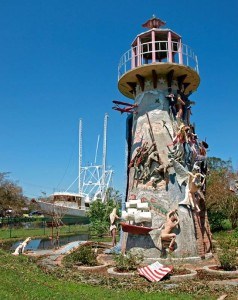
Deborah Cibelli: Thank you very, very much. I'd just like to present our view of the garden. What I've been able to do over the years is to have a compendium of photographs that show, continue, returning of the site by community members with preservation efforts. Loosely, it's preserving the site, restoring the site, whatever you will prefer, in terms of terminology. It will show the community support for the Kenny Hill Sculpture Garden.
As many of you know, the Kohler Foundation has helped to gift the site to Nicholls State University, the university where I teach in the department of art. My training is as an art historian, so I'm going to offer a little bit of commentary on the symbolism more than maybe the physical condition of the sculptures as we go through this, again, compendium of photographs.
From 1988 until he abandoned the site in 2000, it was December 1999 - January 2000, after 12 years, the self-taught artist Kenny Hill created almost 100 cement statues of angels and other figures on several round platforms that he placed around a meandering pathway through the garden in Chauvin, Louisiana, sixty miles southwest of New Orleans. Today, this is the entrance from the bayou view road to the site, with the signage. If you were to go, you would go from U.S. 90 to 24 to 56. Then at Marty J's Chevron you make a left over a little bridge, and you get to Bayouside Drive. Then about a mile and a half down the road, you get to the sculpture garden. We do have a website attached to the Nicholls State University campus website with a little bit more information.
Basically, the garden is located south of U.S. 90 between Houma and Cocodrie. It was built on the banks of the Bayou Petit Caillou. This is a detail of the garden, with the tower and flanking columns, and a view of the bayou. Hill filled his garden with numerous self-portraits and imagery that suggest that the garden was autobiographical and that he had a psychological investment in the religious imagery, such as the angelic figures. The community, including neighbors and persons affiliated with Nicholls State, the institution charged with preserving the site, have responded to the power of the artist's vision, making the site an important community resource for events such as the Blessing of the Fleet, where the priests come down and bless the shrimp boats on the waterways. We're going to have that event, along with the Folk Art Festival on April 19th, on a Sunday afternoon. You will find at that time, a parade of boats that's held annually on the bayou.
This presentation will discuss the preservation, it will examine religious symbolism, and the significance of the site as a type of ritual space for the community, with the link to the water. The chronology begins with Hill starting construction in 1988, at about the age of 40, and continuing to work until he abandoned the site during the winter of 1999-2000. Biology professor Dr. Gary LaFleur, who is affiliated with LUMCON, Louisiana Universities Marine Consortium, contacted Dennis Siporski, department head of art, and Professor Siporski contacted the Kohler Foundation. He was from Wisconsin, and he knew of the foundation's great work, particularly in Sheboygan. Basically, they secured and preserved the site. It's been very important to Nicholls State and to the Kenny Hill site.
They built an NSU studio, it's a Visitor's Center with an exhibition space across the street. The restoration work was funded with restorer Lynn Harrington, who was then located in New Orleans. They also reinforced the site facing the bayou, which we heard about earlier today, and they gifted the site to Nicholls State University. In this instance, we see neighbor Mr. Julius Neil. He recently died, but he has preserved a lot of the oral tradition, and many of the facts that we have about the garden really do come from the contact with Mr. Julius Neil. I'll talk a little bit about Mr. Julius Neil.
This is Kenny Hill's family. I did it in black and white, and color photography so you could see the frames, they've been framed. These are now at the Visitor's Center across the street. They show Kenny Hill's parents, and views of his parents. It's said that he did abandon the site when his mother died.
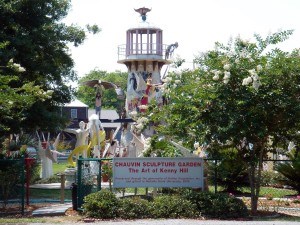
Here we see him inside the house. There's this light, it's actually a light stand with Native American carvings. These are some of his art objects and the artist inside the tower with his brick work, thousands of bricks that went onto the site.
He was separated from his wife and three children, Rita, Mary and Kenny Jr. It was said that, in part, he was responding to that separation when he developed some of the imagery for the site. You can see some of his handiwork with his brick work inside the tower, showing his work as a bricklayer. The first figures that he worked on included this couple. The eagle perched on the man's outstretched arm is visible, was built using cement and rebar construction. The pose of the male with the nude figure, with the eagle on his arm, raising up the woman, could be seen as linked to religious imagery if you compare it to medieval imagery, perhaps with the attribute of John the Evangelist. There's a lot of angels on the site and there are a lot of eagles on the site. The eagle, of course, would be one of the apocalyptic beasts that cry at the last trumpet sounds. Within the context of Hill's biographies, perhaps it's an estranged couple cast out of the paradise like Adam and Eve, awaiting salvation.
Mr. Julius Neil's near the arch. One of the nice things about this particular photograph is it shows one of the incomplete archways where you can see the rebar sticking up. There's also a metal screen where he would build up angel wings and things of that nature. This is the untreated cement. You see the part that is incomplete and it gives you some sense of the building process. He also included this birdhouse, with rooms for rent if you're a bird. A humorous statement on ultimately what would become his plight. In not being able to pay rent, he felt the pressure to ultimately abandon the site. According to Mr. Neil, he was only expected to pay a few hundred dollars a year, but he couldn't raise the money, and he wouldn't accept help from his neighbors. Mr. Neil's house is very, very close to the site. It probably starts around here. He was one of the unofficial tour guides. If you went to work on the site for restoration, he would make gumbo and deliver it. He was very invested, to his credit.
For the rebar construction, I just pulled something to the web, just to remind us that this is armature that one would work with to create things like angels. In this particular instance, the angel holds an hourglass made of salt and pepper shakers. There are found objects that are incorporated into the site. Many of the angels have different dress, you can perhaps come up with some kind of symbolism or iconography to discuss the angels.
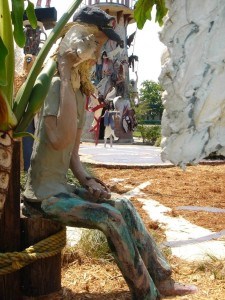
This is the access to the site from Bayouside Road, the way it exists today. The artist created a little artificial bridge over a fake waterway. Then the fence was added, as noted earlier today. Then you can see one of the initial sculptural groups, and then the tower, and then beyond that he adds many of the other components. One of the questions I'll ask is, how do you walk through this garden? Is there a path, if you will? Every time you go, you really find new things to discover. There is no one set pathway, but in some ways there are self-portraits that may guide a viewer through the imagery. Another component of the garden is that it is determined, in part, by the placement of platforms. There are about nine of these cement platforms that have been painted with imagery that recurs, particularly this circular motif with nine discs that seem to echo the layout of the garden. People have been very compelled by the imagery. We get a lot of interpretations, where people really do seem to find symbolism that they think is part of a basic plan. You will see a reference to a figure of Christ in a self-portrait of Kenny Hill. Here, we think these are self-portraits of him being lifted on the columns by eagles. We see pathways with people meandering through the greenery.
This self-portrait of Kenny Hill. He often is wearing a cap with a heart on it. In this instance, he holds a seashell in his hand and he has a horseshoe. The horseshoe is signed "K. Hill," so he does have a signature there. He wears these pants, in this instance it almost looks like camouflage. Some people going to the garden wanted to know whether or not he was a veteran. The family has said that no, he had no military service. If you look at this plan that was made of the garden, you can see where the platforms basically are. We'll look at a number of these platforms. This is the bridge over the fake river. This is where the house once stood. This is where the tower is, the bayou is behind it.
From the house, which would be located in this area, you would see these sculptures along the side. With the house torn down, it gives you a nice open area. We do have sculpture displayed, a moving exhibition of sculpture, in this area here, for the garden. If you walk from the house, you would arrive at what would be a closed gate in this area, and then you would see the couple in this area here. After Gustav, this picture was taken. We have to weather the storms at Chauvin and the water can advance quite high, then it seems to recede. It's been surviving fairly well. We do go back, there's a Friends of the Chauvin Garden. They help coordinate volunteers who clean up the site. After Lynn Harrington's visit, during one restoration period, the community members will wash the sculpture with OxiClean, then they will try to match the paint, and repaint as a sealant, so it is being restored in that way.
The angels at the top of this particular gateway, this is the gateway near the house that has a chain that the artist had that bars your entry. They also seem to hold the swords down with a cross-like motif and flame-like motif. They're dressed, I want to compare them a little bit to Elvis, with the white jackets. They do seem to also wear shrimp boots. That may be a nod to the local area. Some students saw it and they said, "Those angels are wearing shrimp boots." We accept that in general. Again, you have the bayou. You have the couple, if you will. You have the tower, so the house was over in this particular area. There are these flame-like motifs that do occur on some of the platforms.
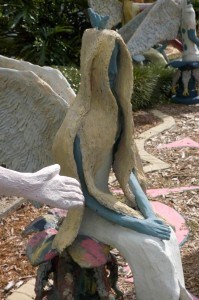
The emphasis placed upon Hill's status as a self-taught artist has shaped the critical view of Hill as uniquely talented, and to some extent, alienated because he would not talk about the work. We must ask whether his work as a mason qualifies him as a folk artist, but even as a mason, he usually functioned an itinerant artist. I've had students at Nicholls who have spoken of Hill building fireplaces and chimneys for their homes in Chauvin before he moved on to other projects. To address Hill's legacy, it seems important to acknowledge his intentions conveyed by his neighbor, Mr. Julius Neil. He wanted the garden to be accessible to the community. He spoke of his own life and personal struggle, and desire to receive God's forgiveness. He wanted viewers to learn from the garden. We might also directly assess the artwork, the formal elements, and the iconography, or subject matter, in light of his stated intentions.
If we view the garden as a record of Hill's journey or struggle, we might also consider the ways in which the viewer moves through the garden space. We can consider the ways in which the organization and subject matter may be related.
Within the interior of the garden, there are several round platforms and sculptural figures on either side of the tall tower. You have seen the views with the figures standing on top of the columns. Male, bearded figures resemble each other and wear jeans. They also have a motif of the nine discs that can occur on the belt buckle of some of the figures. They've been identified by Mr. Neil, and most viewers who knew Hill, as self-portraits. In this instance, what I did is I try to highlight the areas where I thought most of the self-portraits occur, but I think there are more than this. The self-portraits do occur at these intervals.
If you were going to walk into the garden, you would start with the bridge, perhaps. If you're coming from this direction, you might start from the bridge because the gate near the house is closed, so you might start here, you might walk over the artificial walkway.Then you'll come to a sculpture of Hill with his winged hat and his long hair and beard, here blond. In some areas they've been painted brown, in this instance blond. He holds a hand over his bleeding heart. The heart is another motif that's a part of the garden, the angels and the heart.
He did not paint eyes on this figure, so perhaps the message is that he looks inward. You can see the details of this. It's great when the plants are growing. When the plants are growing you get a nice color combination. Along the platform, he has inscribed "Enter Into My Heart and It Is Emty," E-M-T-Y. He uses the motif of the discs within this area, and it's repeated on belt buckles and other components of the garden. There he is, this is our first view as we walk into the garden. He has "Heart of Fact" written on the sidewalk that he created that leads up to this. We've used this as one of the titles for the work, "Heart of Fact."
Of course, we have the motif of the discs, we use it for parking stickers and things. You can see it all over the community. People come to the site, they buy the parking decal. My next goal is to have temporary tattoos, because I think they would be very, very popular at civic events, when we go down to the garden. This again is Gustav, with the angel with the hourglass, and again the flames. The flames, which also occur on angel's heads, is this a type of Pentecostal imagery? You get the flames if you're the apostles and you speak in tongues. Is this a quest for some kind of salvation? These are some of the questions that the imagery raises.
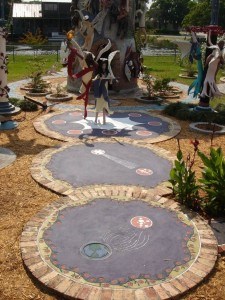
The angels vary. Again, we have a blue figure. This one seems female, with the longer hair, so it's not that male angels are blue, but that the angels are either blue or they're flesh-colored. They vary in design. You can get a sense of the way that some of the pedestals were created and painted in this instance. Mr. Neil describes Kenny Hill using forks and spoons to create the patterns of hair and on the angel's wings, and you do see evidence of that. He's very creative in how he applied the cement and created the textures.
We also have birds' nests, so again, another evidence of nature taking its course, so we do have to go in. Community groups have been very, very good about going in and cleaning. We have Nicholls State maintenance cutting the lawn. We have a member of the faculty, Michael Williams, who is the coordinator at Chauvin, so he helps with the administration of that site.
We've received money from the Houma Regional Arts Council to hire workers, they can be students or community members, to act as docents. You can call, and if they have the personnel, they would have a person try to meet you on the site and give you a tour. The site is open. During daylight, it's open, so you can go and visit. You will not be turned away or find that the gates are shut on the off period.
Again, more angels, more angels. This one is close to Mr. Neil's property. Interestingly enough, it has an eagle on its bodice. The eagle motif, the angel motif, the heart motif, and the discs, these are the elements that recur throughout the garden. This angel, who holds the hourglass, has tears. Eyes and tears. Along the path, some angels assist figures that are traversing the site. Is this a journey? Is this a representation of the artist's journey? Is it a journey that he hopes the community will make? Will the angels assist you on your path? Is it a quest for salvation? Most people seem to accept this as the narrative; however, we have had others who have looked at nine discs and said that it looks like science fiction, and corn circles, and other kinds of things. People do tend to interpret things based on their own experiences.
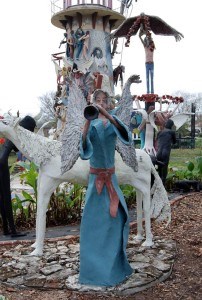
Here we are onto the side, again, and we're going see crosses. There is this reference to Christ, and, we believe, a self-portrait of Hill carrying the cross. That, again, would reinforce religious interpretations. The nine discs occur in this instance. They're radiating light, perhaps. More circular elements. The colonnade itself. On the colonnade, the eagle talons become the pedestals of these columns. You have very interesting mosaic that he creates, and also faces. He put in wires for glasses on one of the figures. Very, very creative, in terms of the architectural design. Then, we believe, this self-portrait of Hill, with the motif on the belt buckle, and being assisted by an angel who points. He points to figures on a path. The idea of journey, pathway, does seem to be referenced within the site. Again, where does Hill occur in other portraits? We do have the motif of the heart and wings on his hat. The horseshoe, perhaps for good luck, and the seashell, maybe a reference to the coastal location. Again, some of these faces with the glasses. These are very, very fragile. I want to say that at least one of those glasses are no longer adhered to the actual column, so we have to preserve it. Again, this photo was taken in 2013, so I'm trying to keep a record of when the photographs were made, so we can compare color, little elements that may have fallen off and deteriorated.
Of course, you could look back to his early career and see the relationship between his light post, with the Native American motif, and the column with the faces. He had translated something that he had made earlier into a more large-scale sculptural work in the medium of cement. More columns with unique designs. Angels on top of this portion of the columns in the colonnade. Nature motifs. Some of the biologists have tried to identify some of the plants. They do see some things that are unique to Louisiana referenced in the imagery. Again columns here.
Then as you move beyond the colonnade, you have the pathway. The angels pointing, and they're pointing to figures that seem to be on this pathway. The figures start in black, and then they emerge in color as they move forward. The path is strewn with flowers. You're moving parallel to the column. Then it ends in an unfinished platform. Mr. Neil has said that the unfinished platform was supposed to be a last judgment, but could you make a last judgment on a relatively small platform? Is the whole garden itself a type of judgment scene? Did he have to reserve it to one little space at the end of the garden? That particular platform is not finished. It's not even really begun. There might be a few pieces of rebar sticking up from the cement platform, and that's it.
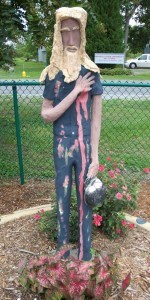
The figures in black. When they occur, they have a path with footprints. They also are accompanied by a figure on horseback, which is another self-portrait. It's another self-portrait of Hill with the belt buckle, we think. He holds a crucifix that has a figure of Christ on it. Again, religious theme is being reinforced. I compare this figure, on one level, to almost the horsemen, maybe, of the apocalypse. Could it be the horsemen of the apocalypse warning us that judgment is ultimately imminent? There are also representation of trumpets within the garden, so that might work with that and might work with the eagle imagery. One of the figures in black. Again, the figures seem forlorn. They look like they're suffering. They're on this pathway. They're grieving. They're mourning. Ultimately they will be joined by other figures in full dress, color, on this path, attended to by angels.
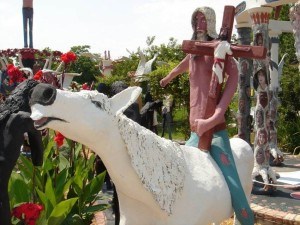
Jazz band, because it's New Orleans and Mardi Gras is ever pervasive, I think. This self-portrait. Native Americans. The women with the waterfall. The eagle motif near the tower. Then ultimately, eagles. The girl. He said he had a vision of a young girl who restored his faith. He places a young girl looking in the waterway near the bayou. That's been repainted. You can see colors will change in these slides, given the work, coming back to the site. Before the tower, there is this relief. I think it's taken from an impression of his face, so we have another portrait. It took me a long time to really see this. You go to the garden, you discover all these really wonderful elements. The Blessing of the Fleet, making it a relevant site every year for the community, linking it with religion too. The biology department brings their boat down. You can get a ride. April 19th. Again, the waterway and hill.
Before he left the site in December 1999, he smashed the arm off of the Christ figure. When restorer Lynn Harrington came to the site, they had the head. Excuse me, not the arm, the head. The head was smashed off. They decided to put the head back on, because they had it in place. Since then, the arm has been so fragile because it reaches outward. That has been damaged. They have the arm and our sculptor, Michael Williams, is thinking that he may try to reattach that arm. Again, Christ and Hill.
Before he abandoned his house, he said, "Hell is here." Again, religious motivation, perhaps, and the trauma of his mother's death may have been another factor in his departure. Of course, we can compare the site to other things like this. I have compared it to a type of pilgrimage site, where people come and they do, in a sense, come back to a place to view religious imagery and to have their boats blessed, almost like a baptism. Thank you very much.
Last updated: April 7, 2025
